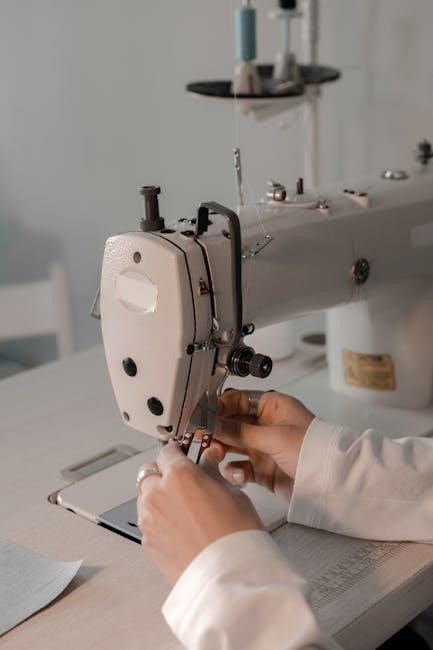The Singer Handheld Sewing Machine is a portable, user-friendly device designed for quick repairs and small projects. It features adjustable thread tension and is ideal for beginners.
1.1 Overview of the Singer Handheld Sewing Machine
The Singer Handheld Sewing Machine is a compact, lightweight device designed for convenience and portability. It features a thread tension dial, take-up lever, and thread cutter for easy operation. Ideal for quick repairs, hemming, and small sewing projects, it is user-friendly for both beginners and experienced users, offering a practical solution for everyday sewing tasks.
1.2 Importance of Reading the Instruction Manual
Reading the instruction manual is crucial for understanding the Singer Handheld Sewing Machine’s features, safety precautions, and proper usage. It provides detailed guidance on threading, operating, and maintaining the machine, ensuring optimal performance and longevity. The manual also includes troubleshooting tips and warranty information, helping users resolve issues and maximize their sewing experience effectively.
Safety Precautions
Always follow safety guidelines to avoid accidents. Keep the machine away from children, avoid direct contact with the needle, and use the rotating dial to control stitching.
2.1 Important Safety Instructions
Always read the manual before use. Keep the machine away from children and avoid direct contact with the needle. Use the rotating dial to control stitching, never pressing or pulling the needle arm. Ensure the machine is turned off during battery replacement or maintenance. Avoid overheating by using the device intermittently and only with Singer-approved accessories.
2.2 Precautions for Using the Handheld Machine
Use only Singer-approved accessories and ensure the machine is on a stable surface. Avoid pressing or pulling the needle arm directly, as this may damage the mechanism. Always use the correct class 15 metal bobbin and compatible thread. Keep the machine away from water and heat sources. Store it in a dry place when not in use to maintain performance and longevity.
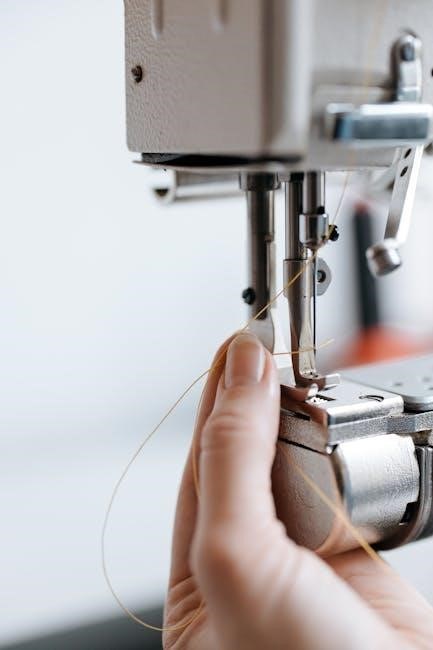
Machine Components and Accessories
The Singer Handheld Sewing Machine includes a thread tension dial, thread take-up lever, and thread cutter. Accessories like bobbins, needles, and a stitch guide are also provided.
3.1 Main Parts of the Singer Handheld Sewing Machine
The Singer Handheld Sewing Machine features a thread tension dial, thread take-up lever, and thread cutter for convenient operation. It also includes a presser foot to hold fabric in place and a bobbin for thread management. These components work together to ensure smooth stitching and easy control during sewing tasks.
3.2 Understanding the Thread Tension Dial and Lever
The thread tension dial adjusts the tightness of the upper thread, ensuring proper stitch formation. The take-up lever controls thread flow during sewing. Correctly setting these ensures balanced stitches, preventing fabric bunching or loose threads. Adjusting these components is crucial for achieving professional-looking results in various fabrics and stitch types.
3.3 Accessories Included with the Machine
The Singer Handheld Sewing Machine comes with essential accessories, including a standard sewing needle, a class 15 metal bobbin, and a thread cutter for trimming ends. These components ensure smooth operation and maintenance. The machine also includes a detailed instruction manual, providing guidance for setup, usage, and troubleshooting, helping users make the most of their sewing experience.
Threading the Machine
Threading the Singer Handheld Sewing Machine involves inserting thread through the spool pin, guiding it through the tension dial, and trimming excess thread after securing it tightly;
4.1 Step-by-Step Guide to Threading
Begin by placing the thread on the spool pin. Gently guide the thread through the tension dial, ensuring it clicks into place. Next, pass the thread through the take-up lever and finally through the presser foot. Pull the thread to secure it, leaving a small loop to sew effectively. Trim any excess thread carefully for optimal performance.
4.2 Common Threading Issues and Solutions
Common threading issues include thread not moving smoothly or uneven tension. Ensure the thread is properly seated in the tension dial and take-up lever. If thread is too tight, adjust the tension dial. For loose thread, gently pull to secure. Always use the correct needle size and type for your fabric to avoid threading problems and ensure smooth sewing.
Using the Machine
The Singer Handheld Sewing Machine operates smoothly with adjustable stitch length and tension. Ideal for small repairs, it is portable and easy to use on various fabrics and stitches.
5.1 Basic Operations of the Handheld Sewing Machine
Begin by turning on the machine and selecting the desired stitch length. Gently place the fabric under the presser foot, ensuring it aligns with the feed teeth. Use the handgrip to guide the fabric smoothly. The machine automatically moves the fabric as you sew. Always use the thread cutter to trim ends neatly. Keep the machine on a flat surface for stable operation.
5.2 Tips for Smooth Sewing
For smooth sewing, always use the correct needle type and thread suitable for your fabric. Place fabric evenly under the presser foot and guide it gently with both hands. Keep the work area clean to avoid thread tangles. Use the thread cutter for neat finishes. Ensure the machine is properly threaded and tension is adjusted. Avoid pulling fabric too hard, as it may misalign stitches. Regularly check the bobbin for proper insertion and sufficient thread. Turn off the machine when not in use and store it in a dry place. Always use the power switch to control operation and keep the machine on a flat, stable surface for consistent results.

Maintenance and Care
Regularly clean the machine to remove dust and debris. Lubricate moving parts as needed to ensure smooth operation. Store the machine in a dry, cool place to prevent damage and rust. Always unplug it when not in use and avoid exposure to moisture.
6.1 Cleaning and Lubrication Tips
Regularly clean the machine with a soft brush to remove dust and debris. Lubricate moving parts periodically to ensure smooth operation. Use a dry cloth to wipe exterior surfaces and avoid moisture exposure. Proper care extends the machine’s lifespan and maintains its performance for consistent stitching and reliable use over time.
6.2 Storage and Handling Guidelines
Store the Singer Handheld Sewing Machine in a dry, cool place, away from direct sunlight and moisture. Use a protective case or cover to prevent dust accumulation. Avoid exposing the machine to extreme temperatures or physical stress. Always handle the device with care to prevent damage. Clean the machine before storing it to maintain its performance and longevity.

Troubleshooting Common Issues
Identify and resolve issues like thread jams, uneven stitches, or machine malfunction. Check thread tension, clean debris, and ensure proper needle alignment for smooth operation.
7.1 Common Problems and Their Solutions
Common issues include thread jams, uneven stitching, or machine malfunction. Solutions involve checking thread tension, ensuring proper needle alignment, and cleaning debris. Regular maintenance resolves most problems.
7.2 Error Messages and How to Resolve Them
Common error messages include “Thread Jam” or “Low Power.” To resolve, check thread tension, clear debris, and ensure proper battery installation. For persistent issues, refer to the troubleshooting guide or contact Singer support for assistance. Regular maintenance helps prevent these errors and ensures smooth operation of the machine.
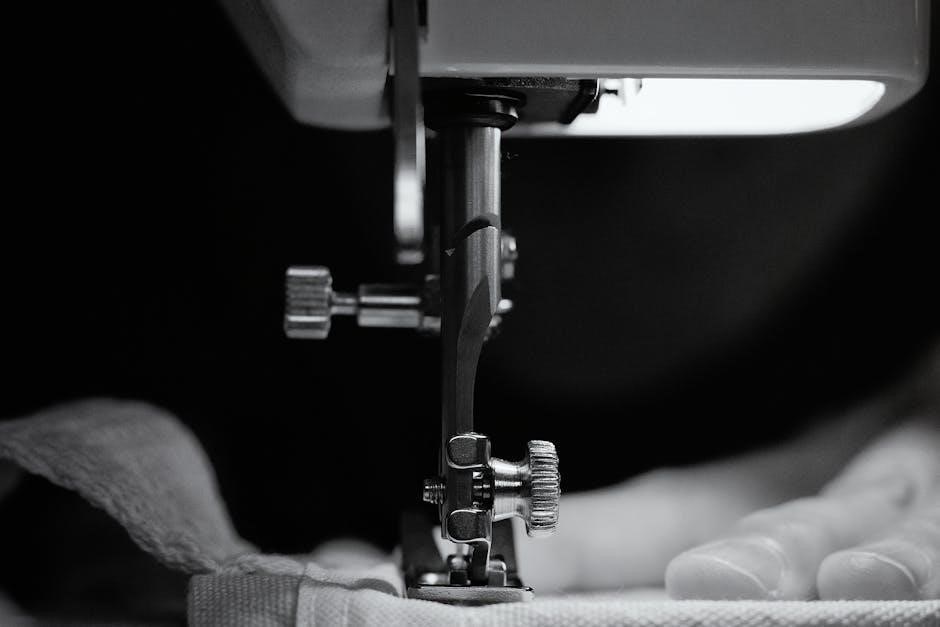
Downloading the Instruction Manual
Visit Singer’s official website, navigate to the manuals and updates section, and download the free PDF manual for your specific machine model. Supported brands include Singer, PFAFF, and Husqvarna Viking.
8.1 Where to Find the Singer Sewing Machine Manual
The Singer sewing machine manual can be found on the official Singer website. Visit the manuals and updates section, where you can search for your machine by model number and download the free PDF manual. This service supports various Singer models, including popular ones like the SINGER 4452, ensuring easy access to guides and updates.
8.2 Steps to Download the Manual
To download the Singer sewing machine manual, visit Singer’s official website. Navigate to the Manuals and Updates section. Search for your machine by model number, then select and download the PDF manual. This process is quick, ensuring you have all necessary guides and updates for your Singer handheld sewing machine. Manuals are now exclusively online as part of Singer’s Green Initiative.
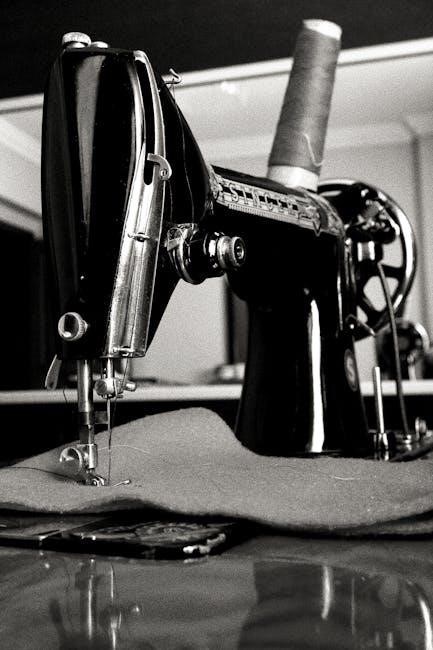
Warranty and Support
Singer offers comprehensive warranty coverage for their sewing machines, ensuring durability and performance. Dedicated customer support is available through their official website for inquiries and assistance. Visit Singer’s support page for detailed warranty information, terms, and conditions, as well as contact options for any questions or concerns about your handheld sewing machine.
9.1 Warranty Information for Singer Sewing Machines
The Singer handheld sewing machine comes with a comprehensive warranty that covers parts and labor for a specified period. Singer stands behind the quality of its products, ensuring reliability and performance. For detailed warranty terms, visit Singer’s official website or refer to the manual. Warranty coverage may vary by model and region, so registration is recommended for full benefits. Always check the official Singer website for the most accurate and updated warranty information.
9.2 Contacting Singer Customer Support
For assistance with your Singer handheld sewing machine, visit Singer’s official website for contact details. Support options include phone, email, and live chat. Additionally, Singer offers extensive online resources, such as FAQs, troubleshooting guides, and downloadable manuals. Registered users can access exclusive support features. Ensure to have your machine’s model number ready for efficient service. Singer’s customer support team is available to address inquiries and provide solutions promptly.
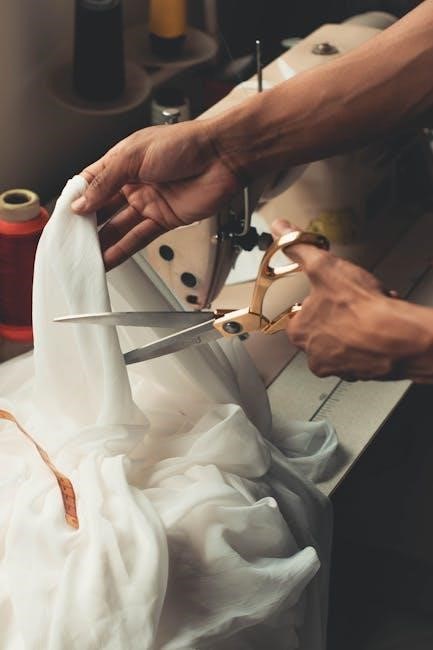
Additional Resources
Explore online tutorials, sewing guides, and communities for tips. Singer’s official website offers manuals, FAQs, and troubleshooting. Join forums for shared experiences and expert advice.
10.1 Online Tutorials and Guides
Find video tutorials and step-by-step guides on Singer’s official website and sewing forums. These resources cover machine setup, troubleshooting, and advanced techniques. They are ideal for beginners and experienced users alike.
10.2 Sewing Communities and Forums
Join sewing communities on Facebook, Reddit, and specialized forums to connect with experts and enthusiasts. Share tips, troubleshoot issues, and gain inspiration for projects. Singer’s official community also offers exclusive advice and resources for handheld machine users, fostering a supportive environment for sewists of all skill levels.
Tips for Getting the Most Out of Your Machine
Experiment with fabric types, adjust thread tension, and use the correct needles for optimal results. Regular maintenance ensures smooth operation and extends machine longevity.
11.1 Optimizing Stitch Quality
To optimize stitch quality, ensure proper thread tension by adjusting the dial according to fabric type. Use the correct needle size and install it with the flat side facing forward. Maintain consistent fabric movement and keep the machine clean. Regular lubrication and proper presser foot adjustment also enhance stitching accuracy and overall performance.
11.2 Experimenting with Different Fabrics
Start with lightweight fabrics like cotton and gradually move to heavier materials. Adjust the thread tension dial for optimal results. Use appropriate needle sizes for different fabrics, ensuring proper penetration and stitch formation. For delicate fabrics, reduce tension, while denser fabrics may require increased tension. Experiment with textures like denim, silk, or fleece to master various sewing techniques and achieve professional-looking results.
Congratulations on completing the Singer Handheld Sewing Machine manual! This versatile tool empowers your creativity and practicality in sewing. Happy stitching and endless creativity!
12.1 Final Thoughts on Using the Singer Handheld Sewing Machine
The Singer Handheld Sewing Machine is a portable, user-friendly tool perfect for quick repairs and small projects. Its adjustable thread tension and included accessories make it ideal for both beginners and experienced sewists. By following the manual, you can ensure safe operation and optimal performance. Happy sewing and enjoy the creative possibilities this machine offers!
12.2 Encouragement to Practice and Explore Sewing Techniques
Practice regularly to master the Singer Handheld Sewing Machine and explore creative sewing techniques. Experiment with various fabrics and stitches to expand your skill set. Don’t hesitate to try new projects—each one is an opportunity to learn and improve. Embrace the joy of creating something unique and tailor-made with your machine!
